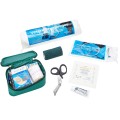
What is a "denier," and why does it matter?
Most horse rugs have a 600D, 1200D, or 1680D rating. The higher the denier count, the tighter the weave of the threads and the longer the fabric will last.
How heavy should the rug be?
There are rugs of different weights to keep your horse comfortable all year:
Lightweight (with no fill) cotton blends, mesh, or net for summer days.
Lightweight (up to 100 - 150 g) or medium weight (200 – 300 g) for cooler weather in spring and autumn.
Heavy weight (300 - 500g) for those freezing temperatures in winter.
When the weather and temperature change, it's best to have rugs of different weights or thicknesses that you can layer to keep your horse warm without making them too hot.
Which rug should you put on?
Horses have a natural thermoregulation system that keeps their body temperature at about 38C. When their temperature changes outside of the normal range, it’s bad for their health. So, it's important to respect this natural process and don’t rush to put on a heavy rug whenever you’re feeling chilly.
Your horse may need a heavier rug in the rain and cold if they:
Have trouble keeping their weight up or are underweight.
Have limited access to hay or grass.
Don’t have shelter when turned out.
Spend lots of time in a stable.
Have just been clipped.
Are currently training and exercised heavily.
How do you know if the rug fits?
A rug that fits right will protect your horse from the weather and let them move freely without any pressure points or rubs. A rug that doesn't fit right is not only uncomfortable, but it can also injure your horse if it slips or gets a leg caught in it.
Before buying a new rug, here’s how to measure your horse for the best fit:
Place a soft tape measure in the middle of their chest, in line with the widest part of their shoulder.
Run the tape along one side of their body to the widest part of their hindquarter (where the rug would end).
Turn out rugs are usually sized in 3 inch increments (69”, 72”, 75”, etc.) If your horse is between sizes, go for the smaller size.
Follow these steps to see if the rug fits:
Fold the rug in half by bringing the tail end up to the neck.
Place the folded rug over your horse's back with the chest straps over their shoulders.
Fasten the chest straps and make sure you can slide your hand down the rug's neck.
Lead your horse in a figure of eight and check that their shoulders move freely without the rug slipping back.
Unfold the rug along the horse's back.
The end of the rug (or seam of the tail flap if it has one) should be just past the top of the horse's tail. If it sits above or below that, it is either too short or too long for your horse.
Any surcingles should cross in the middle of the horse's stomach, well in front of their stifle. You should be able to place a hand between the straps and their belly.
If the rug has leg straps, put the left leg strap between the back legs and hook it to the left D-ring along the back edge.
Pass the right leg strap between the back legs, through the loop of the left leg strap, and fasten to the other D-ring on the right.
By crossing the leg straps in this way, the rug stays in place and doesn't rub.
To give your horse room to move, loosen the leg straps until your hand fits between the leg straps and your horse's thigh (about 4 to 5 inches).
Remember to take their rug off at least once a day and look for any sign of rubbing, damp coat, skin problems and weight gain or loss. Rugged horses need to be groomed well and often to keep oils, dirt, and loose hair from building up.
How do you look after rugs?
No matter how good or expensive your rug is, it will get worn and torn over time, even if you’re lucky to have a "rug friendly" horse. But your rugs will last longer if you take good care of them.
Check the fabric for small tears and the buckles, surcingles, and leg straps often to make sure they are in good shape. Your rugs will last longer if you repair any small damage as soon as you notice it. A good rug repair service can fix rips and tears and replace broken straps and buckles.
Before putting your lightweight rugs away for the winter:
Give them a good wash following the manufacturer's washing instructions or take them to a professional rug washing service.
Air them out and make sure they’re completely dry before storing.
Check for wear and tear on the leg straps, buckles, surcingles, fillet strings, and any D-rings. If you find any damage, have it fixed or replaced.
Rugs made of canvas can be re-proofed and left to dry.
Store them in an airtight, rodent-proof bin to keep them clean and ready for the next season.


%20(500%20x%20500%20px)%20(500%20x%20500%20px)%20(500%20x%20500%20px)%20(500%20x%20500%20px)%20(500%20x%20500%20px)%20(30)-120x120.jpg)



%20(1)-120x120.jpg)

%20(500%20x%20500%20px)%20(500%20x%20500%20px)%20(500%20x%20500%20px)%20(500%20x%20500%20px)%20(500%20x%20500%20px)%20(69)-120x120.jpg)
%20(500%20x%20500%20px)%20(500%20x%20500%20px)%20(500%20x%20500%20px)%20(500%20x%20500%20px)%20(2)-120x120.jpg)
%20(500%20x%20500%20px)%20(500%20x%20500%20px)%20(500%20x%20500%20px)%20(500%20x%20500%20px)%20(500%20x%20500%20px)%20(63)-120x120.jpg)
%20(500%20x%20500%20px)%20(500%20x%20500%20px)%20(500%20x%20500%20px)%20(500%20x%20500%20px)%20(500%20x%20500%20px)%20(75)-120x120.jpg)
%20(500%20x%20500%20px)%20(500%20x%20500%20px)%20(500%20x%20500%20px)%20(500%20x%20500%20px)%20(7)-120x120.jpg)
%20(500%20x%20500%20px)%20(500%20x%20500%20px)%20(500%20x%20500%20px)%20(500%20x%20500%20px)%20(500%20x%20500%20px)%20(79)-120x120.jpg)
%20(500%20x%20500%20px)%20(500%20x%20500%20px)%20(500%20x%20500%20px)%20(500%20x%20500%20px)%20(500%20x%20500%20px)%20(24)-120x120.jpg)
%20(500%20x%20500%20px)%20(500%20x%20500%20px)%20(500%20x%20500%20px)%20(500%20x%20500%20px)%20(12)-120x120.jpg)
%20(500%20x%20500%20px)%20(500%20x%20500%20px)%20(500%20x%20500%20px)%20(500%20x%20500%20px)%20(10)-120x120.jpg)


%20(500%20x%20500%20px)%20(500%20x%20500%20px)%20(500%20x%20500%20px)%20(500%20x%20500%20px)%20(18)-120x120.jpg)

%20(500%20x%20500%20px)%20(500%20x%20500%20px)%20(500%20x%20500%20px)%20(500%20x%20500%20px)%20(500%20x%20500%20px)%20(20)-120x120.jpg)



Leave a Comment